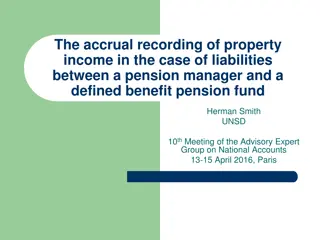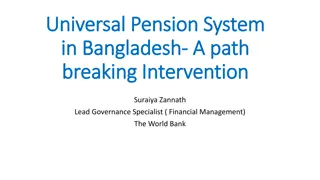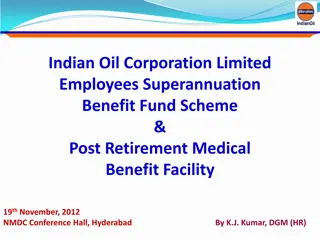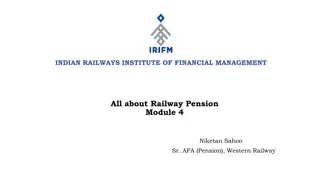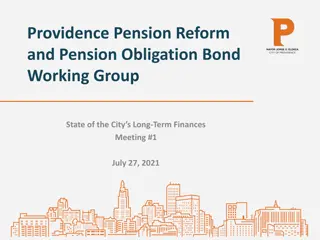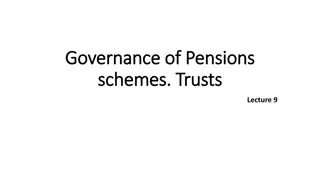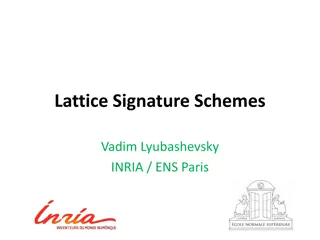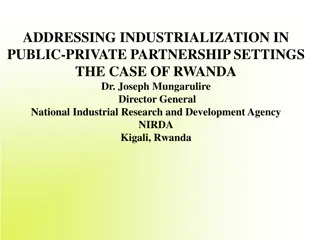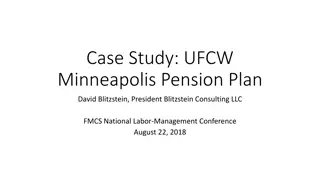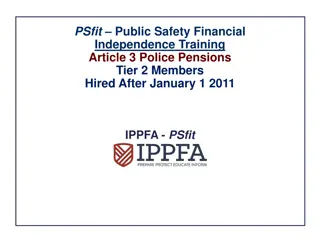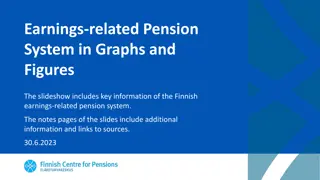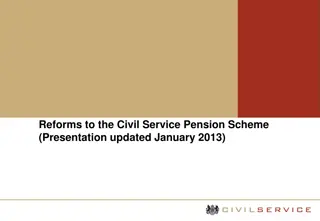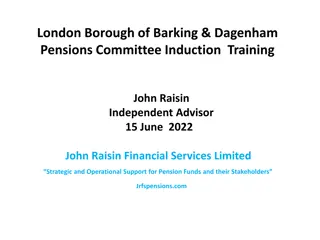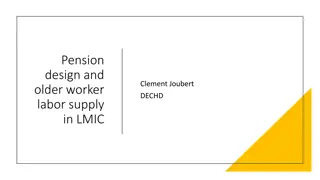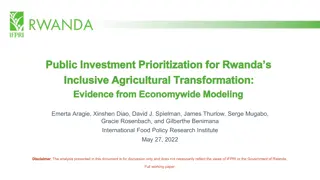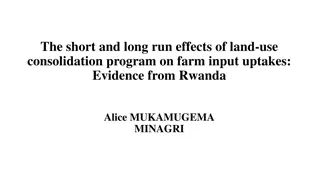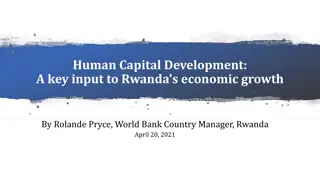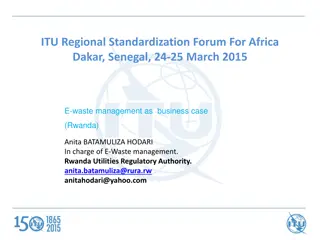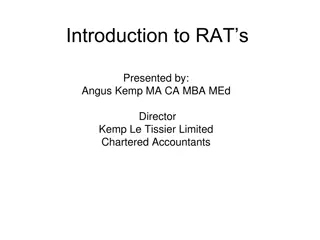Understanding Defined Contribution vs. Defined Benefit Pension Schemes in Rwanda
Explore the impact of Defined Contribution (DC) and Defined Benefit (DB) pension schemes on Rwanda's socio-economic landscape. Discover the differences, benefits, risks, and implications of each scheme type within the Rwandan pension sector, including how they influence social and economic outcomes.
Download Presentation

Please find below an Image/Link to download the presentation.
The content on the website is provided AS IS for your information and personal use only. It may not be sold, licensed, or shared on other websites without obtaining consent from the author. Download presentation by click this link. If you encounter any issues during the download, it is possible that the publisher has removed the file from their server.
E N D
Presentation Transcript
DC SCHEMES AND ITS SOCIO ECONOMIC EFFECT ON RWANDA PRESENTED BY: AXIS PENSIONS LTD. ..Your Reliable Partner in Pensions Tuesday, October 1, 2024
AGENDA Agenda 01 DC AND DB SCHEMES 02 02 THE PENSIONS LANDSCAPE IN RWANDA 03 03 HOW DC SCHEMES CAN THRIVE 04 04 SOCIAL EFFECTS OF DC SCHEMES 05 05 ECONOMIC EFFECTS OF DC SCHEMES 06 06 WAY FORWARD
Defined contribution scheme A pension scheme that provides pension scheme benefits based on the contributions invested, the returns received on that investment (minus any charges incurred) Normally a contributory scheme where employer and/or employee may both contribute Benefits depend on contributions made and investment performance of the fund Risk is assumed by contributing members like any investment account Relatively easier to track monitor and plan The use of actuaries are not a must, as long as there is a strong risk management framework and policy A novelty which has more pension schemes converting to
Defined benefit scheme The world is gradually moving away from this type of schemes because it may not be sustainable Benefits are based on a preconceived formula and not necessarily on contributions received Risk of investments is assumed by sponsor and not the member. Members hence may not enjoy the full upside benefits when investments are good Members do not get affected by the downside Beyond other professional service providers, an actuary is required to provide actuarial valuations to ascertain the status and sustainability of the scheme at regular intervals
The Rwandan pension landscape NATIONAL BANK OF RWANDA (BNR) (BNR) NATIONAL BANK OF RWANDA Complementary Occupational Pension Schemes (employer sponsored standalone schemes or multi-employer schemes) multi-employer schemes) Complementary Occupational Pension Schemes (employer sponsored standalone schemes or Mandatory Basic National Social Security Scheme Scheme Personal Pension Schemes (for individuals or groups, formal sector and informal sector) sector and informal sector) Mandatory Basic National Social Security Personal Pension Schemes (for individuals or groups, formal RSSB RSSB Approved Trustees (Licensed by BNR) (Licensed by BNR) Approved Trustees (Board of Trustees) (Board of Trustees) Scheme Administrator Pension Fund Pension Fund Custodian Custodian Pension Fund Manager Manager Pension Fund
The Rwandan pension landscape Trustees play a central role being responsible for the entire operation of the fund. Employer Fund Manager Members Trustees cannot play effective role without efficient systems for administration communication Trustees and RRA Custodian Auditor Admin.
Necessary conditions for dc schemes to thrive Sound regulatory environment A thriving investment management industry A buoyant capital market Human capital Strong corporate governance Independence of service providers
Social effect of DC schemes Improved Income replacement ratio Globally accepted IR ratio 70% Rwanda IR is estimated @ 40% (predominantly due to low contributions od 8% to the RSSB scheme) Supplementary DC schemes can potentially replace income up to over 100% Old Age poverty
Social effect of dc schemes Income security and Financial fall back Years RWF 15,000.00 RWF 30,000.00 RWF 50,000.00 RWF 70,000.00 RWF 100,000.00 5 1,161,556 2,323,112 3,871,854 5,420,595 7,743,707 10 3,072,675 6,145,349 10,242,249 14,339,149 20,484,498 15 6,217,055 12,434,110 20,723,517 29,012,924 41,447,035 20 11,390,533 22,781,065 37,968,442 53,155,819 75,936,884 25 19,902,501 39,805,002 66,341,670 92,878,338 132,683,340 30 33,907,319 67,814,638 113,024,396 158,234,155 226,048,792 35 56,949,571 113,899,142 189,831,903 265,764,664 379,663,805 40 94,861,194 189,722,387 316,203,979 442,685,571 632,407,958 Assumptions: i. Average interest rate 10% per annum ii. Contributions remain constant iii. 5% inflation
Social effect of DC schemes Income security and Financial fall back Years RWF 15,000.00 RWF 30,000.00 RWF 50,000.00 RWF 70,000.00 RWF 100,000.00 5 1,020,091 2,040,182 3,400,304 4,760,426 6,800,608 10 2,329,234 4,658,468 7,764,114 10,869,760 15,528,228 15 4,009,334 8,018,668 13,364,447 18,710,226 26,728,894 20 6,165,505 12,331,010 20,551,683 28,772,357 41,103,367 25 8,932,646 17,865,291 29,775,485 41,685,680 59,550,971 30 12,483,880 24,967,759 41,612,932 58,258,104 83,225,864 35 17,041,386 34,082,773 56,804,621 79,526,470 113,609,243 40 22,890,302 45,780,605 76,301,008 106,821,411 152,602,016 Assumptions: i. Average interest rate 10% per annum ii. Contributions remain constant iii. 5% inflation
Social effect of dc schemes Income security for the informal worker Provides an avenue for pensions for all citizens via personal pension schemes Prior to Law No 03/15 Governing the organization of Pension Schemes in Rwanda, there was no pension scheme for the informal sector Complements government efforts vis a vis Ejo Heza scheme Informal sector is estimated to employer 70%+ of the labour force of Rwanda
economic effect of dc schemes Positive effect on gross domestic savings and GDP growth Year Brazil China India Malaysia Singapore South Africa 1980-90 19.9 36.1 20.9 24.8 39.0 24.4 Gross saving (% of GDP) 1991-00 16.7 40.7 24.0 34.7 47.6 16.6 2001-11 16.8 47.4 31.5 35.5 43.2 15.5 1980-90 3.0 9.8 5.7 5.9 7.8 2.2 1991-00 1.7 10.0 5.7 7.2 7.3 1.4 Average GDP growth (%) 2007-11 3.4 10.0 6.9 5.1 5.6 3.5 Sources: IMF,Nomvuyo Guma and Lumengo Bonga-Bonga
economic effect of dc schemes A prominent study by Rodrik(2000) showed that the average savings rate of the 31 fastest growing countries(in terms of GDP per capita) in the period 1984-94 was 24% of GDP. In contrast the average savings rate of 59 countries in which GDP per capita income grew at less than 1% stood at 16%
Contribution of dc schemes to Rwandas vision 2050 Time Frame Vision Economic lanscape Present day Bangladesh or even surpass present day Georgia 2035 High Middle Income Status 2050 High income status With a gdp per capita growth of 7% average income will reach US $2,400 (2017 prices) This implies that Rwanda has to grow faster than its current gdp per capita growth of 4% to 10% to achieve this landmarks The vision 2050 can be anchored on income based goals, and in order to stimulate rapid growth, local long term savings mobilization strategies are key, DC schemes could be a game changer Source: Drivers of growth for Rwanda publication conference edition
Contribution of dc schemes to debt sustainability From the graph above, it is very clear that a bulk of national debt are foreign held. Upon maturities of these debts if they are not retired well, it lead to some shocks to the economy particularly on exchange rates, there are some examples of countries that experienced sharp depreciation of their currency due to activities of external investors.
Contribution of dc schemes to sustaining economic growth Rwanda s domestic savings and investment rates from 1995-2015 Sources: calculations based on data from world development indicators (World Bank, various years) and National Institute of statistics of Rwanda data. Note FDI =foreign direct investment; ODA = official development assistance
Dc schemes a source of sustainable and reliable savings Item Contributors (RSSB) average salary Contibution rate Average Contributions Contributions Value 530,000 250,000 5% 12500 RWF 6,625,000,000.00 Investment Rate Annual contribution Contributions with interest 1 year Contributions with interest 5 year Contributions with interest 10year 9% RWF 79,500,000,000.00 RWF 82,862,759,609.37 RWF 499,684,907,131.72 RWF 1,282,032,085,676.92 Estimated GDP 2017 PP AUM in 2027 9.137 Billion Usd 1.4 Billion Usd 13.72 Billion Usd GDP estimate for 2027 (assuming an average growth rate of 7% year on year) AUM share of GDP in 2027 10% NB:Assumptions: average salary 12,500 RWF; all RSSB contributors contribute to a DC scheme, average contribution rate 5% of Average Salary, Average interest rate: 9% Per Anum
Contribution of dc schemes to sustaining economic growth Capital and financial market development Industrialization and urbanization Human capital development Bridging funding gaps
Way forward Step 4 Enforcement of retirement savings laws and implementation Step 2 Awareness creation for the retirement savings industry Step 1 Step 3 Enforcement of retirement savings laws Introduction of incentives by government



